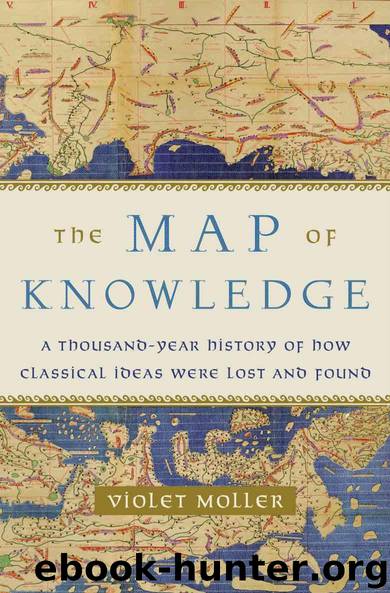The Map of Knowledge by Moller Violet

Author:Moller, Violet [Moller, Violet]
Language: eng
Format: azw3, epub
Publisher: Knopf Doubleday Publishing Group
Published: 2019-05-13T16:00:00+00:00
* The setting for Umberto Eco’s classic novel, The Name of the Rose, a murder mystery which explores the intellectual world of a fourteenth-century monastery.
SIX
Salerno
Tum medicinali tantum florebat in arte,
Posset ut hic nullus languor habere locum.
[Salerno] then flourished to such an extent in the art of medicine
that no illness was able to settle here.
—Alfano I, Archbishop of Salerno
IN THE MIDDLE of the eleventh century, a North African merchant called Constantine arrived in the busy Italian port of Salerno with a consignment of goods. During his stay in the city, he fell ill, so a local doctor was summoned to his bedside. We don’t know what treatment this doctor prescribed or whether he contributed to Constantine’s recovery, but we do know that Constantine was shocked by the doctor’s incompetence—the man hadn’t even asked for a urine sample on which to base his diagnosis. Many people would have shrugged off the experience, thanked God they had survived, and hurried back to their more civilized homeland. Fortunately for the development of European medicine, Constantine was an unusual character. He remained in Salerno and began to question local people about what kind of medical books were available there, only to be horrified when the answers indicated how little the Italians knew about medicine.
If this story had happened in any other city in Europe at that time, it would have been unremarkable—understandable, even. Medical knowledge was rudimentary in Western Europe in the second half of the first millennium. Doctors were few and far between. There were some medical texts in Carolingian monasteries and in the libraries of the imperial court, but not many people had read and understood them. When they were sick or injured, the overwhelming majority relied on a combination of prayer, blind hope and (often) unsavoury amulets bought from local healers.*1 The sublime irony of Constantine’s story is that he was lucky enough to fall ill in Salerno—then the most advanced centre of medical learning in the whole of Europe. The physician whose knowledge he scorned was, in fact, at the cutting edge of Western clinical science, and had been trained by the best physicians, using the most up-to-date texts available. Salerno’s reputation was such that it was known, in Europe, at least, as the Civitas Hippocratica. But Constantine’s disdain for the treatment on offer eloquently demonstrates the chasm that existed between European scholars and their Muslim counterparts. The Arabic-speaking world had benefited from centuries of medical scholarship and research. They had hospitals, practical guides, diagnostic tools and specialized equipment to treat the sick and the injured. When Constantine discovered that the medical treatment he had received was better than anything else on offer in Europe, he resolved to help.
Constantine returned to his native Carthage, where he began to study and then practise medicine. A few years later, he again sailed to Salerno, bringing with him a cache of books that would transform the study and practice of medicine in Europe, and enhance Salerno’s position as the major centre of medical teaching.
Download
This site does not store any files on its server. We only index and link to content provided by other sites. Please contact the content providers to delete copyright contents if any and email us, we'll remove relevant links or contents immediately.
| Africa | Americas |
| Arctic & Antarctica | Asia |
| Australia & Oceania | Europe |
| Middle East | Russia |
| United States | World |
| Ancient Civilizations | Military |
| Historical Study & Educational Resources |
The Daily Stoic by Holiday Ryan & Hanselman Stephen(3107)
The Fate of Rome: Climate, Disease, and the End of an Empire (The Princeton History of the Ancient World) by Kyle Harper(2870)
People of the Earth: An Introduction to World Prehistory by Dr. Brian Fagan & Nadia Durrani(2619)
Ancient Worlds by Michael Scott(2492)
Babylon's Ark by Lawrence Anthony(2427)
Foreign Devils on the Silk Road: The Search for the Lost Treasures of Central Asia by Peter Hopkirk(2385)
The Daily Stoic by Ryan Holiday & Stephen Hanselman(2341)
India's Ancient Past by R.S. Sharma(2293)
MOSES THE EGYPTIAN by Jan Assmann(2275)
The Complete Dead Sea Scrolls in English (7th Edition) (Penguin Classics) by Geza Vermes(2135)
Lost Technologies of Ancient Egypt by Christopher Dunn(2109)
The Earth Chronicles Handbook by Zecharia Sitchin(2100)
24 Hours in Ancient Rome by Philip Matyszak(1973)
Alexander the Great by Philip Freeman(1960)
Aztec by Gary Jennings(1877)
The Nine Waves of Creation by Carl Johan Calleman(1783)
Curse Tablets and Binding Spells from the Ancient World by Gager John G.;(1768)
Before Atlantis by Frank Joseph(1740)
Earthmare: The Lost Book of Wars by Cergat(1715)
